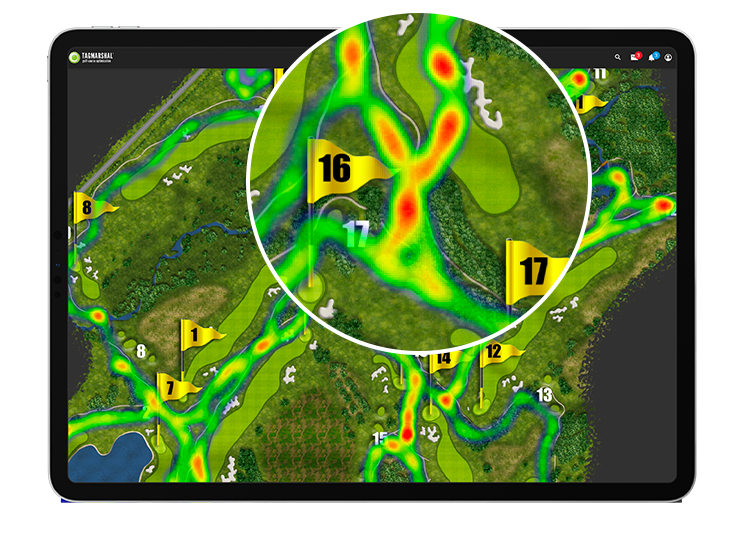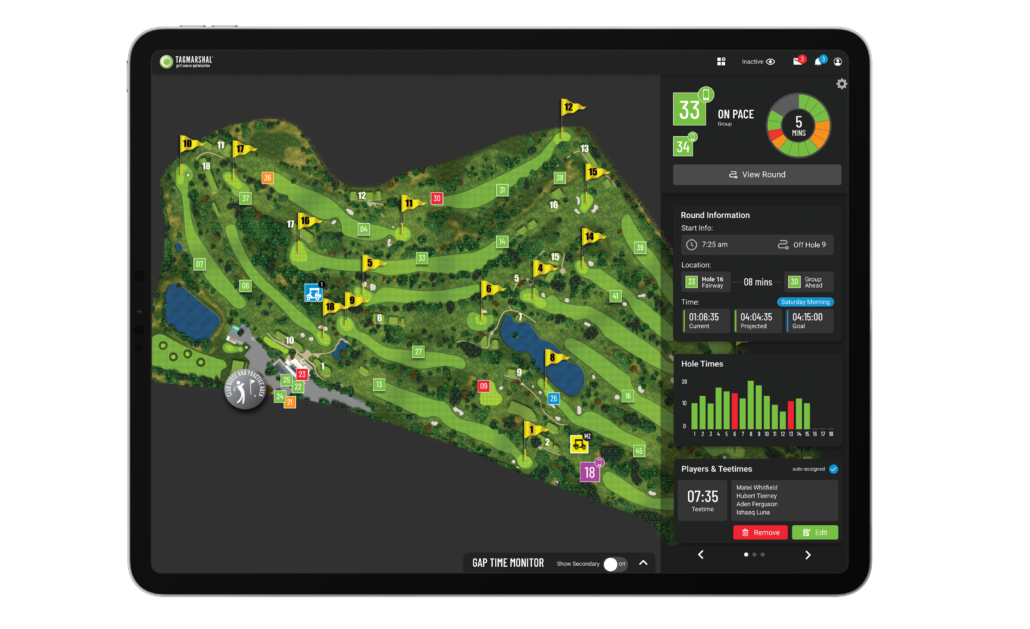Pace Technology Golf Course Maintenance: How Layout Can Affect Pace Of Play
In a world leaning more and more towards digital optimization, plenty of golf courses have implemented pace technology golf tools to improve pace of play. Along with course conditioning, pace of play is one of the biggest factors that determine a golfer’s enjoyment out on the course. The importance of pace of play is twofold; it directly affects golfers’ experience and enjoyment of their round and can also ultimately have a big impact on a golf club’s monetary performance.
Keeping the playing tempo up is crucial to not only get as many golfers coming through the proverbial doors as possible, but also to keep them happy – which ultimately drives loyalty, affecting a golf club’s bottom line positively. And while golfers’ conduct on the course is often to blame for slow play, many course maintenance and layout strategies, with the help of pace technology golf tools, can be implemented to combat the bane of the game.
Club managers and superintendents are faced with the challenging dilemma of reducing the duration of rounds while making it challenging enough for the better player, but not too challenging for the inferior player at the same time – no easy feat by any means. However, through course optimization with Tagmarshal’s pace technology golf tools, this can all be achieved with ease. Read on to find out more.
Course Maintenance And Its Role In Pace Of Play
When it comes to course maintenance for improving pace of play, the rough setup is a key factor that can (and should) be considered. Aside from spending more time battling to find balls, the longer the rough becomes, the more challenging it is to hit from, which often requires more dedication, concentration and, ultimately, time. Not to mention that mishits are prevalent which results in not just extra shots, but extra shots from the same areas. But what can be done, from a maintenance perspective, to decrease the search time of wayward drives?
The solution is not to head out with the mowers and shorten roughs or widen fairways on the course as far as the eye can see. The key lies in doing this with intent, in the areas that need it most. Determining these areas without the help of Tagmarshal’s Heatmap Visualization would be labor-intensive, extremely time-consuming, and costly. On the other hand, with the heatmap, users can gauge which areas of roughs are over-utilised, and which parts of the rough are most often frequented, allowing you to attend to these spots specifically, to decrease slow play.
Rough Around Greens
Once again, thick rough around the green can be a nuisance for many a golfer, and can be a thorn in the side of the course marshal or manager trying to keep the pace of play on schedule. Delicate chips around the putting surface can easily result in blading or chunking the ball due to longer-than-needed rough, resulting in the same player needing to take the same time for the same shot once more, which naturally increases the time on the hole.
Pace technology golf tools like Tagamarshal’s Heatmap Visualization can, once again, easily identify the areas around the green where the pace slows down. If the analytics show that certain greens are taking longer to play through than others, it can be an indication that the specific area is in need of maintenance work to increase the efficiency of play.
Green Speed
For pace of play, mastering the green speed of a course can be a tricky business. If a green runs too quick, the golfer may battle to get the line right. If the greens run too slowly, one needs to putt harder which can mess with rhythm and tempo, resulting in bad putts. In either case of these two extremes, it will result in more golfers having to putt more and thus spend more time on each hole.
According to the USGA, several factors play a part in the appropriate green speed for a specific course, and while most golfers think they want faster greens, the reality is that it’s not in the best interest of them, the course, or any other player around them as it leads to slower rounds – which will ultimately make things less enjoyable for everyone involved.
If you’re a superintendent wondering what your course’s ideal green speed is for the optimal pace of play, Tagmarshal’s pace technology golf tools may be exactly what you need. The Analytics Hub can track how different green speed affects play time with pinpoint accuracy, and based on this information, or more specifically, analytics, changes can be implemented to ensure the best pace of play possible at the course.
Pace Technology Golf Tools: Course Layout And Setup
The layout and setup of a course can also dramatically affect the pace of play. Superintendents and course managers are challenged with setting up the course in a way that is fair, but at the same time testing enough so that better players still face a challenge – at the end of the day, it’s all about finding the right balance.
Bringing the course hazards or bunkers into play can have a major effect on pace. Not just because of the time it may take to recover from the obstacles, but also because of the time players take strategizing on how to avoid them in the first place.
Green Location And Slope
The undulation of greens and where they’re located can significantly influence the pace of play, too. For example, the extreme slopes of Augusta National would mean golfers take much more time to read putts or adjust their approaches compared to the wide and flat planes of St. Andrews.
Bunker Placement And Recovery Areas
Bunker placement on a golf course can have a considerable impact on pace of play, which is why pace technology golf tools like Tagmarshal’s Live Map will come in handy. This Live Map helps maintenance teams mitigate slow play before it has a lasting effect and will assist them in attending to disturbed bunkers during natural gaps in play to make sure they’re in a playable condition for the next player/s.
How Technology Helps Optimize Course Maintenance For Better Pace of Play
Tagmarshal’s Live Map: Performing Maintenance During Field Gaps
Maintaining course conditions without disrupting the flow of play when golfers are on the course is an important aspect of providing a seamless and enjoyable experience – but it’s much easier said than done. Until now, maintenance teams would have to rely on set schedules and guesswork from past experience to try and gauge the best times to do so. However, modern pace technology golf tools, like Tagmarshal’s Live Map, are transforming how this is accomplished in today’s digital age.
By leveraging real-time data, the technology enables golf course managers to balance upkeep and pace of play seamlessly by identifying natural gaps in play. These gaps occur when no groups are placed between specific holes, which creates a window of opportunity for staff to perform tasks like mowing, irrigation, moving hole locations etc. For example, during busy times with a full field, there may be small but significant intervals between groups, like on longer holes, that present opportunities for brief maintenance.
Using Heatmap Visualization To Inform Maintenance Decisions
Tagmarshal’s Heatmap Visualization pace technology golf tool offers extremely valuable insights into the impact of overuse on areas around the course. This Utilization Heatmap helps course managers make data-driven decisions about course setup, maintenance, and cart path enforcement by visualizing usage patterns. Course managers and superintendents can select specific timeframes (like a day or month) to analyze cart and walker movements tracked by geolocation. From there, it’s a simple matter of zooming into specific areas, such as fairways or greens, to identify usage hotspots and compare them with expected patterns. The tool also integrates with Tagmarshal’s geofencing module to improve cart path monitoring and signage needs.
Analytics Hub: Measuring Impact Of Maintenance Adjustments
Tagmarshal’s Analytics Hub feature provides course managers with the ability to measure the impact of their maintenance and adjustment efforts on the overall pace of play. By consistently collecting data on player movements and round times, pace technology golf tools like the Analytics Hub offer insights into how certain changes to the course layout can affect the speed of play. This allows managers to track the effects of maintenance strategies directly, helping to identify which adjustments improve the pace (or worsen it, for that matter).
For example, if adjustments have been made to the speeds of greens that have notoriously been causing bottlenecks, the Analytics Hub can measure and show the effect on round times immediately once the alterations have been made. If the pace technology golf data shows that players are completing these holes quicker, course managers can confidently implement this strategy across similar areas. On the other hand, if a change has minimal or negative impact, they can quickly pivot to find other solutions.
Layout adjustments are another area where the Analytics Hub proves invaluable. For instance, moving the tees so that fairway bunkers are out of play or reshaping the rough in landing zones can help prevent slow play by making recovery shots easier. By tracking player flow and round times before and after these adjustments, Tagmarshal’s Analytics Hub allows course managers and superintendents to see whether these changes have accelerated play, and takes the guesswork and a trial-and-error approach out of the equation.
In this way, the Analytics Hub serves as a powerful tool for golf courses, enabling continuous improvement of course conditions and the overall player experience. By leveraging data-driven insights, course managers can refine strategies to maintain an optimal balance between challenging play and a smooth, efficient on-course flow, all while improving player enjoyment and operational efficiency.
Pace Technology Golf Tools: Improve Pace Of Play Today
In this day and age, golf course managers need not rely on dated methods to improve pace of play. With effective maintenance and course layout that is backed by data and analytics, any golf course’s pace of play can be improved. Strategic adjustments to key areas can help eliminate dreaded bottlenecks, ensuring a smoother and more enjoyable playing experience that will keep golfers coming back for more.
By integrating pace technology golf tools like Tagmarshal’s Live Map, Heatmap Visualization, and Analytics Hub, courses can make data-driven decisions that optimize pace, course conditions, and ultimately, the playing experience. This leads to improved operational efficiency for course managers and staff, which equates to not only saving costs but increasing revenue at the same time.
If you, too, would like to stay competitive and provide the best possible golfing experience for your golfers, get in touch with us today and let Tagmarshal help you streamline your operations.







 WATCH DEMO
WATCH DEMO